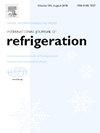不同结构超声速喷嘴内氦凝聚的数值研究
IF 3.5
2区 工程技术
Q1 ENGINEERING, MECHANICAL
International Journal of Refrigeration-revue Internationale Du Froid
Pub Date : 2025-07-05
DOI:10.1016/j.ijrefrig.2025.07.003
引用次数: 0
摘要
本研究创新性地将超音速两相膨胀器应用于氦气液化过程。为了说明氦的自发凝聚,本工作描述了一个数值模型的构建,其准确性由Moses和Wyslouzil喷嘴验证。模拟结果表明,将收敛段从0.13385 m延长到0.16385 m,使出口液质量分数从14.502%提高到14.896%,使顶形核率从6.350 × 1019 m−3·s−1提高到8.371 × 1019 m−3·s−1。当扩散段膨胀角由2.4°增大到3.2°时,出口温度由3.072 K降低到2.766 K,出口液分率由13.381%增加到14.933%。研究结果表明,延长会聚段和增大膨胀角有利于氦的冷凝,这是旋流喷嘴设计的基础。本文章由计算机程序翻译,如有差异,请以英文原文为准。
Numerical study on helium condensation in supersonic nozzles of various structures
This study innovatively applies Supersonic Two-Phase Expander to the helium liquefaction process. In order to illustrate the spontaneous condensation of helium, this work describes the construction of a numerical model, the accuracy of which is verified by both Moses and Wyslouzil nozzles. Simulation results indicate that lengthening the convergent section from 0.13385 m to 0.16385 m enhances the outlet liquid mass fraction from 14.502 % to 14.896 % and raises the zenith nucleation rate from 6.350 × 1019 m−3·s−1 to 8.371 × 1019 m−3·s−1. When the expansion angle of the divergent section is raised from 2.4° to 3.2°, the outlet temperature shows a reduction from 3.072 K to 2.766 K, whereas the outlet liquid fraction grows from 13.381 % to 14.953 %. The findings elucidate that lengthening the convergent section and increasing the expansion angle can facilitate helium condensation, which is fundamental to the design of the swirling nozzle.
求助全文
通过发布文献求助,成功后即可免费获取论文全文。
去求助
来源期刊
CiteScore
7.30
自引率
12.80%
发文量
363
审稿时长
3.7 months
期刊介绍:
The International Journal of Refrigeration is published for the International Institute of Refrigeration (IIR) by Elsevier. It is essential reading for all those wishing to keep abreast of research and industrial news in refrigeration, air conditioning and associated fields. This is particularly important in these times of rapid introduction of alternative refrigerants and the emergence of new technology. The journal has published special issues on alternative refrigerants and novel topics in the field of boiling, condensation, heat pumps, food refrigeration, carbon dioxide, ammonia, hydrocarbons, magnetic refrigeration at room temperature, sorptive cooling, phase change materials and slurries, ejector technology, compressors, and solar cooling.
As well as original research papers the International Journal of Refrigeration also includes review articles, papers presented at IIR conferences, short reports and letters describing preliminary results and experimental details, and letters to the Editor on recent areas of discussion and controversy. Other features include forthcoming events, conference reports and book reviews.
Papers are published in either English or French with the IIR news section in both languages.

 求助内容:
求助内容: 应助结果提醒方式:
应助结果提醒方式:


